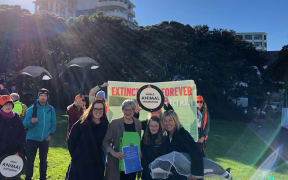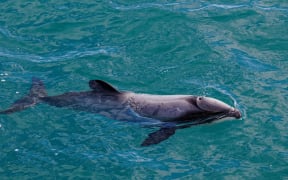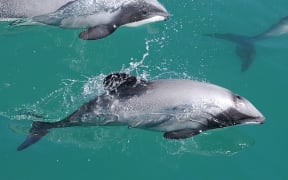Two fishing companies and WWF want drones, new rules, and support for out-of-work fishers as part of a package to protect Māui dolphins.

Māui dolphins. Photo: Supplied.
The government's proposals to protect the dolphins include bans on set nets and trawling out as far as 12 nautical miles offshore, or 100m deep, between Maunganui Bluff and New Plymouth, with smaller bans elsewhere along the coast.
World Wildlife Fund for Nature (WWF) along with Sanford and Moana Seafoods are calling for some smaller exclusion areas, and more of a focus on technical and scientific solutions to stop the dolphins being caught.
Those include drones to spot dolphins, a mandatory 'move on' rule when they are spotted; and a 30-day local closure if a dolphin is caught.
They also want more support for fishers who will lose work if bans on set nets and trawling are introduced.
And they want more dedicated research into the threat toxoplasmosis poses to the dolphins.
WWF New Zealand chief executive Livia Esterhazy said although some of their fishing-exclusion areas are smaller than the government was proposing, that's less important than monitoring exactly where the dolphins are.
"That means using technology that is available to us now - drones, acoustic sound, thermal imagery - to tell fishermen in real time there is a pod of dolphins close to you and for those fishermen to move on and stop fishing immediately," she said.
"Both Moana and Sanford have agreed and committed to the 'move on' rule of any dolphin within 10 nautical miles of being pinged," Ms Esterhazy said.
WWF had "absolutely not" been captured by industry, she said.
"Everything that we have put down is backed on science, and also the science has led us to looking at a different approach and that's the innovation: how can we do this differently?
"If there is a 10 nautical mile radius of protection around these dolphins wherever they move in real time, that is more protection than any of [the government's] options are offering those dolphins.
"[The government's] options are algorithmic lines in the sand of best guesses and best estimates of where these dolphins are," she said.
"Dolphins in reality don't know where that line in the sand is," she said.
Sanford chief executive Volker Kuntzsch said there were methods of mitigating the risk to Māui dolphins other than prohibiting fishing altogether.
"There's so much technology available these days that would get us onto a very different level that is not considered," he said.
That could include dolphin dissuading devices, or using cameras under water to identify what swims into the net and allow the fishers to release any unwanted bycatch.
"And then real time management, that is something that, especially with climate change these days, needs to be considered very carefully."
Mr Kuntzsch said there had been no reports of a Māui dolphin by the fishing industry in 14 or 15 years.
Ms Esterhazy told Morning Report the government options were looking at the dolphins but not the consequences for the fishing industry.
"We need to look at both - if we're going to restrict fishing what do we do with the fishermen whose lives and livelihoods ... will be affected."
Otago University Professor Liz Slooten, an expert on dolphins, said the idea of having boats move on when dolphins were located in the water was unrealistic.
"The chances of seeing such a rare animal are very small, even close to the vessel you'll miss dolphins when they're under water."




